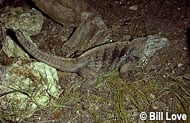Grand Cayman Blue Iguana
Cayman Islands
This large, heavy-bodied lizard is not for everyone. The Grand Cayman blue iguana grows large and requires more room to give it a proper domain in captivity. Much better is setting up an outdoor pen if you live in the southern one-quarter of the United States or other region where winters aren’t severe. The walls of pens must be buried at least two feet into the ground to prevent escape by these powerful diggers.
Primarily vegetarians, Grand Cayman blue iguanas are more accurately described as omnivorous because animal matter is readily consumed when offered. The bulk of their diet, though, should consist of a varied mix of greens and fruits heavier on the fibrous greens. Grand Cayman blue iguanas eat voraciously after a morning period warming up in the sun or heat lamps. Strong lights must be used in captive situations to compensate for the sun’s intensity so these thick lizards can reach optimal temperatures as they would in nature.
A single specimen, or at most a sexual pair does best per each enclosure. Multiple males will fight and simply doesn’t work. Clutches of 5 to 13 eggs are deposited in underground burrows dug by females.

